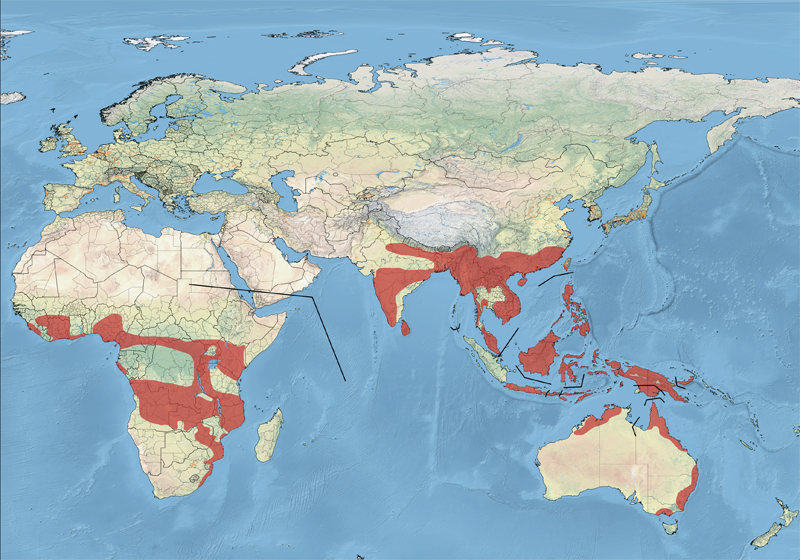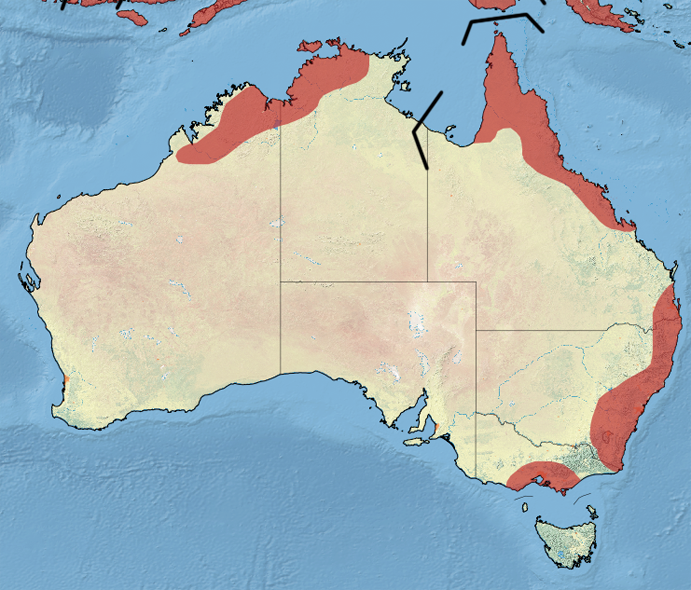Hi All
I am searching for King Quail sub species Coturnix chinensis victoriae. I believe the victoriae sub species is very rare, shame considering how common the pet shop variety is. So far I have read there is a population on French island and scattered sightings the rest of vic. I am really hoping someone has wild sourced Victorian King Quails (legally obtained of course) or at least seen these little guys in the vic scrub.
Any information will be greatly appreciated.
Cheers
Victorian King Quail
- GregH
- ...............................

- Posts: 1671
- Joined: 17 Feb 2009, 08:20
- Location: Brisbane
- Location: Chapel Hill, Brisbane Qld
There are 29 records for this subspecies on the Atlas of Living Australia site if you want to check them out. I'm sure there'll be many more on birding sites although the twitchers won't like you eyeing them off!
- Nrg800
- ...............................

- Posts: 597
- Joined: 16 Dec 2010, 21:29
- Location: Sydney
By just searching at a species level of ALA you get an additional 8 records in Victoria (http://biocache.ala.org.au/occurrences/ ... ecordsView)
Birdline Victoria lists three records, all from French Island and of multiple individuals (http://www.eremaea.com/BirdlineSpeciesArchive.aspx)
A Birding Aus search for "King Quail Victoria" gives the following: http://bioacoustics.cse.unsw.edu.au/arc ... 00256.html
http://bioacoustics.cse.unsw.edu.au/arc ... 00169.html
http://bioacoustics.cse.unsw.edu.au/arc ... 00299.html
http://bioacoustics.cse.unsw.edu.au/arc ... 00331.html
http://search.informit.com.au/documentS ... res=IELHSS was a report published in Australian Field Ornithology about the subspecies in Victoria
http://bird.net.au/bird/index.php?title=King_Quail - On the species in South Western Victoria
I'll edit this with more after I get around to making a map for King Quail Distribution.
Edit:

This is the global distribution of the King Quail (including the African Rain Quail, which is sometimes split), with data from The IUCN Red list, and subspecies data from IBC Birds.
Here is the Australian Distribution:

In Australia we have two subspecies C.c. colletti in Northern Australia, and C. c. victoriae in Eastern Australia. Neither are at all common, but colletti is slightly more abundant than victoriae, the only place I have heard of being semi-reliable for the latter in the Southern part of its range is the Richmond Lowlands (where there's normally one or so seen a year), but these get more and more abundant the further north you go, with 6 or 7 being seen a year up in Northern NSW (Boyters Lane, Jerseyville is particularly well-reported) and more in Southern Queensland.
To address your original query; I cannot imagine that there are any in captivity. Although they're considered as Endangered in Victoria, I cannot find any management plan relating to the species (The closest I can find is the management plan for French Island National Park http://parkweb.vic.gov.au/__data/assets ... -np-mp.pdf) which would be where the need for a captive breeding program would be addressed, without this, there would not be permission granted to taking individuals from the wild, and no-one would consider it a good idea.
Birdline Victoria lists three records, all from French Island and of multiple individuals (http://www.eremaea.com/BirdlineSpeciesArchive.aspx)
A Birding Aus search for "King Quail Victoria" gives the following: http://bioacoustics.cse.unsw.edu.au/arc ... 00256.html
http://bioacoustics.cse.unsw.edu.au/arc ... 00169.html
http://bioacoustics.cse.unsw.edu.au/arc ... 00299.html
http://bioacoustics.cse.unsw.edu.au/arc ... 00331.html
http://search.informit.com.au/documentS ... res=IELHSS was a report published in Australian Field Ornithology about the subspecies in Victoria
http://bird.net.au/bird/index.php?title=King_Quail - On the species in South Western Victoria
I'll edit this with more after I get around to making a map for King Quail Distribution.
Edit:

This is the global distribution of the King Quail (including the African Rain Quail, which is sometimes split), with data from The IUCN Red list, and subspecies data from IBC Birds.
Here is the Australian Distribution:

In Australia we have two subspecies C.c. colletti in Northern Australia, and C. c. victoriae in Eastern Australia. Neither are at all common, but colletti is slightly more abundant than victoriae, the only place I have heard of being semi-reliable for the latter in the Southern part of its range is the Richmond Lowlands (where there's normally one or so seen a year), but these get more and more abundant the further north you go, with 6 or 7 being seen a year up in Northern NSW (Boyters Lane, Jerseyville is particularly well-reported) and more in Southern Queensland.
To address your original query; I cannot imagine that there are any in captivity. Although they're considered as Endangered in Victoria, I cannot find any management plan relating to the species (The closest I can find is the management plan for French Island National Park http://parkweb.vic.gov.au/__data/assets ... -np-mp.pdf) which would be where the need for a captive breeding program would be addressed, without this, there would not be permission granted to taking individuals from the wild, and no-one would consider it a good idea.
Latest Lifer: Black-headed Gull (HaLong Bay. #528)
Australia List: 324 (White-throated Nightjar)
Global Year List: 119 (Powerful Owl)
Australia List: 324 (White-throated Nightjar)
Global Year List: 119 (Powerful Owl)
- Kquail
- ...............................

- Posts: 8
- Joined: 01 Jun 2012, 22:26
- Location: Melbourne
Wow.
Thanks for the detailed replies and efforts. I was in contact with a person from Iramoo (Sustainable Community Centre) that had "native King quails" breeding some time ago. I asked the question but unfortunately they do not keep live animals in the centre anymore. I did not pursue it further to find out if these were in fact victoriae and where they sourced them. I spose I can still ask the question.
Would be great if some victoriae stock were introduced for breeders to help bring back the endangered tag. I am also trying to find what distinguishes the victoriae sub from the rest.
Search continues!
Cheers
Thanks for the detailed replies and efforts. I was in contact with a person from Iramoo (Sustainable Community Centre) that had "native King quails" breeding some time ago. I asked the question but unfortunately they do not keep live animals in the centre anymore. I did not pursue it further to find out if these were in fact victoriae and where they sourced them. I spose I can still ask the question.
Would be great if some victoriae stock were introduced for breeders to help bring back the endangered tag. I am also trying to find what distinguishes the victoriae sub from the rest.
Search continues!
Cheers
- Nrg800
- ...............................

- Posts: 597
- Joined: 16 Dec 2010, 21:29
- Location: Sydney
Pretty much the problem with that, is that wild-sourced stock will not be domestic like what we have now. They will be a lot harder and more expensive for the same as what we have already, and it only takes one person to screw up all the genetics.
I haven't been able to find anything on the difference between the subspecies, even looking at the papers of the ornithologist that split the subspecies hasn't found any notes on why. It may just be genotypic differences, or the populations not interbreeding, and having been separate long enough for there to be the subspecies distinction.
I haven't been able to find anything on the difference between the subspecies, even looking at the papers of the ornithologist that split the subspecies hasn't found any notes on why. It may just be genotypic differences, or the populations not interbreeding, and having been separate long enough for there to be the subspecies distinction.
Latest Lifer: Black-headed Gull (HaLong Bay. #528)
Australia List: 324 (White-throated Nightjar)
Global Year List: 119 (Powerful Owl)
Australia List: 324 (White-throated Nightjar)
Global Year List: 119 (Powerful Owl)
- Kquail
- ...............................

- Posts: 8
- Joined: 01 Jun 2012, 22:26
- Location: Melbourne
Hi
Got some images.
http://collections.museumvictoria.com.a ... irn=424174
http://collections.museumvictoria.com.a ... irn=466175
Any King quail experts spot a difference?
Cheers
Got some images.
http://collections.museumvictoria.com.a ... irn=424174
http://collections.museumvictoria.com.a ... irn=466175
Any King quail experts spot a difference?
Cheers
- elferoz777
- ...............................

- Posts: 1752
- Joined: 01 Feb 2012, 22:15
- Location: Fairy Meadow, NSW
Would not say I am an expert but the eye colour and shade of that hen look different to most of the hens I have ever kept.
In saying that mine are the common type and I guess due to mutations they would more than likely not be their true native colour.
Got me curious now........
I think the difference may be gene based as suggested above. For example their is a subspecies of goldfinch living in Britain compared to the rest of Europe...ill be dammed if I could tell the difference there apart from the location where they have lived in isolation.
Good luck
In saying that mine are the common type and I guess due to mutations they would more than likely not be their true native colour.
Got me curious now........
I think the difference may be gene based as suggested above. For example their is a subspecies of goldfinch living in Britain compared to the rest of Europe...ill be dammed if I could tell the difference there apart from the location where they have lived in isolation.
Good luck
Breeding Project 2020-2025.
agate mosaic canaries, agate yellow mosaic canaries, red zebs, self bengos and goldfinch mules.
agate mosaic canaries, agate yellow mosaic canaries, red zebs, self bengos and goldfinch mules.
- Danny
- ...............................

- Posts: 794
- Joined: 02 May 2011, 08:04
- Location: Sunshine Coast, QLD
- Contact:
Its a fake glass eye so it was whatever the taxidermist had on his shelfelferoz777 wrote:Would not say I am an expert but the eye colour and shade of that hen look different to most of the hens I have ever kept.
In saying that mine are the common type and I guess due to mutations they would more than likely not be their true native colour.
Got me curious now........
I think the difference may be gene based as suggested above. For example their is a subspecies of goldfinch living in Britain compared to the rest of Europe...ill be dammed if I could tell the difference there apart from the location where they have lived in isolation.
Good luck
- finchbreeder
- ^^^^^^^^^^^^^^

- Posts: 11497
- Joined: 27 Jun 2009, 20:00
- Location: Midwest of West. Aust. Coast
- Location: Midwest of West.Aust.Coast
My computor and the links are having a disagreement so can't look. Sorry.
LML
LML
LML

